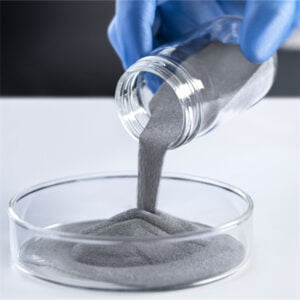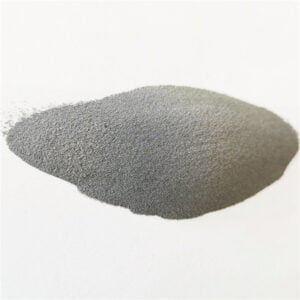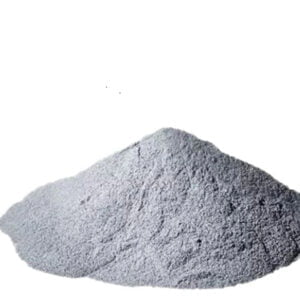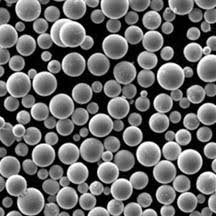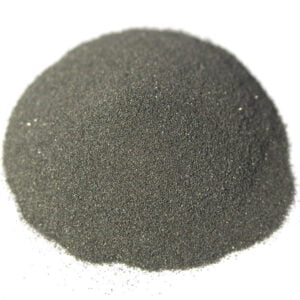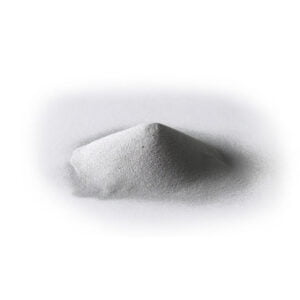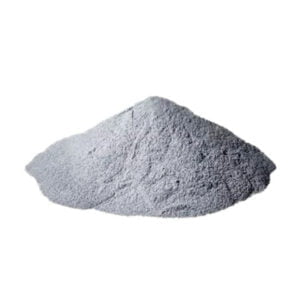Pulver av titanlegering
Allt du behöver veta om leverantörer av metallpulver för 3D-utskrift
Produktkategori

Pulver av titanlegering består av titan blandat med andra metalliska element som aluminium, vanadin, järn och molybden. Pulvren tillverkas genom gasförstoftning, en process som använder högtrycksgas för att förvandla smält legering till fina sfäriska partiklar idealiska för additiv tillverkning.
Titanlegeringar erbjuder det bästa förhållandet mellan styrka och vikt av alla metalliska material. De är starka som stål men 45% lättare. När de produceras som fina pulver blir titanlegeringar lämplig råvara för avancerade tillverkningstekniker som selektiv lasersintring (SLS), elektronstrålesmältning (EBM) och bindemedelssprutning. Dessa metoder tillåter intrikata former och anpassade mönster som inte är möjliga med traditionell tillverkning.
Titan och dess legeringar utmärker sig för sin korrosionsbeständighet i tuffa miljöer. De tål saltvatten, syror och klor mycket bättre än aluminium, magnesium eller stållegeringar. Titan är också inert och giftfritt när det implanteras i människokroppen. Denna biokompatibilitet gör den ovärderlig för medicinsk utrustning och implantat.
Med avancerade egenskaper som hög hållfasthet, låg densitet, korrosionsbeständighet och biokompatibilitet möjliggör titanlegeringspulver lättare, starkare och mer hållbara delar inom flyg-, bil-, medicin-, kemi-, marin- och konsumentindustrin.
Titanlegering pulver sammansättning
Titanlegeringspulver innehåller främst titan tillsammans med legeringselement för att förbättra styrka, hårdhet och prestanda vid hög temperatur. De vanligaste titanlegeringarna är Ti-6Al-4V, Ti-6Al-4V ELI och Ti-3Al-2,5V.
| Legering | Sammansättning |
|---|---|
| Ti-6Al-4V | 90% titan, 6% aluminium, 4% vanadin |
| Ti-6Al-4V ELI | 90% titan, 6% aluminium, 4% vanadin, låga interstitiella föroreningar |
| Ti-3Al-2,5V | 95% titan, 3% aluminium, 2,5% vanadin |
Andra legeringsämnen som järn, molybden, zirkonium, tenn, tantal eller niob kan vara närvarande i små mängder. Sammansättningen kontrolleras noggrant för att uppnå målegenskaper efter additiv tillverkning.
Egenskaper hos titanlegeringspulver
De unika egenskaperna hos titanlegeringar i pulverform möjliggör avancerad tillverkning, rymd, medicinsk och andra ledande tillämpningar.
| Fastighet | Ti-6Al-4V | Ti-6Al-4V ELI | Ti-3Al-2,5V |
|---|---|---|---|
| Täthet | 4,43 g/cm3 | 4,43 g/cm3 | 4,48 g/cm3 |
| Smältpunkt | 1604°C | 1604°C | 1615°C |
| Draghållfasthet | Min 1170 MPa | Min 1100 MPa | Min 1095 MPa |
| Utbyteshållfasthet | Min 1035 MPa | Min 1035 MPa | Min 1000 MPa |
| Töjning | 10-15% | 8-15% | 8-10% |
| Elastisk modul | 114 GPa | 114 GPa | 115 GPa |
| Utmattningshållfasthet | 485 MPa | 485 MPa | 450 MPa |
| Brottseghet | 75 MPa-m^1/2 | 60 MPa-m^1/2 | 65 MPa-m^1/2 |
| Termisk konduktivitet | 7 W/mK | 7 W/mK | 6,7 W/m-K |
| Elektrisk resistivitet | 170-190 μΩ-cm | 170-190 μΩ-cm | 172 μΩ-cm |
| Koefficient för termisk expansion | 8,6 μm/m-°C | 8,6 μm/m-°C | 8,8 μm/m-°C |
Egenskaperna hos tryckta delar beror på den additiva tillverkningsprocessen samt värmebehandling efter tryckning. Till exempel genererar elektronstrålesmältning (EBM) finare mikrostrukturer och bättre mekaniska egenskaper jämfört med selektiv lasersmältning (SLM). Efterbearbetning som varm isostatisk pressning (HIP) kan ytterligare förbättra densitet, ytfinish, dimensionsnoggrannhet och materialprestanda.
Tillämpningar av titanlegeringspulver
Några av de viktigaste användningsområdena för titanlegeringspulver inkluderar:
| Industri | Tillämpningar |
|---|---|
| Flyg- och rymdindustrin | Motorkomponenter, skrovdelar, fästelement, hydraulsystem |
| Medicinsk | Implantat, kirurgiska instrument, tandrötter, tandställning |
| Fordon | Vevstakar, ventiler, fjädrar, fästelement, växlar |
| Kemisk | Pumpar, ventiler, rör, värmeväxlare, reaktionskärl |
| Olja och gas | Borrkronor, kompletteringsverktyg, undervattenskomponenter |
| Kraftproduktion | Turbinblad, värmeväxlare, ång- och gasledningar |
| Sportartiklar | Golfklubbor, cykelramar, hockeyklubbor, lacrosseklubbor |
| Konsumentvaror | Klockor, glasögon, smycken, smartphones, kameror |
Titanlegeringar möjliggör lätta, högpresterande konstruktioner över branscher där styrka, korrosionsbeständighet och biokompatibilitet är avgörande. Flexibiliteten i pulvermetallurgin tillåter produktion av komplexa, nätformade delar som inte är möjlig med konventionella titankvarnprodukter.
Titanlegering pulver Specifikationer
Titanlegeringspulver finns i olika storleksintervall, sammansättningar, produktionsmetoder och renhetsnivåer. Här är några av de viktigaste specifikationsparametrarna:
| Parameter | Typiska värden |
|---|---|
| Partikelstorlek | 10-45 μm, 15-53 μm, 45-150 μm |
| Partikelns form | Sfärisk, oregelbunden |
| Produktionsmetod | Gasatomisering, plasmaroterande elektrodprocess, hydrid-dehydrid |
| Renhet | Årskurs 1, 2, 3, 4, 5 |
| Legeringsklass | Ti-6Al-4V, Ti-6Al-7Nb, Ti-555, Ti-1023, etc. |
| Skenbar densitet | 2,5-4,5 g/cm3 |
| Tappdensitet | Upp till 80% materialdensitet |
| Syrehalt | 3000-5000 ppm |
| Kväveinnehåll | 150-500 ppm |
| Innehåll av väte | 100-200 ppm |
| Flödeshastighet | Upp till 25 s/50 g |
| Specifik ytarea | 0,1-1,0 m2/g |
Specifikationerna är baserade på ASTM B988 för gasatomiserat sfäriskt titanlegeringspulver och andra internationella standarder. Anpassade sammansättningar och partikelegenskaper finns också tillgängliga för specialiserade applikationer.
Prissättning av titanlegeringspulver
Prissättningen för titanlegeringspulver beror på många faktorer:
| Faktor | Påverkan på priset |
|---|---|
| Legeringens sammansättning | Högre legeringshalt ökar kostnaderna |
| Renhetsgrad | Högre renhetsgrader är dyrare |
| Fördelning av partikelstorlek | Mindre storlekar är prissatta högre |
| Produktionsmetod | Plasma- och HDH-pulver kostar mer än finfördelad gas |
| Orderkvantitet | Priserna minskar med större orderkvantiteter |
| Förpackning | Argonrensade förseglade burkar kostar extra |
Några vägledande prisintervaller:
- Ti-6Al-4V-pulver 15-45 μm: $50-80/lb
- Ti-6Al-4V-pulver 45-150 μm: $30-50/lb
- Små partier i förseglade burkar är ~30% högre
- Plasma Ti-6Al-4V-pulver: $120-150/lb
- Pulver av renhetsgrad 1: $200-300/lb
Kontakta välrenommerade leverantörer som AP&C, Tekna och Advanced Powders för offertpris baserat på dina specifika krav. Var försiktig med lågprispulver från okända källor med tveksam kvalitet.
Jämförelse av titanpulverproduktionsmetoder
Jämförelse av titanpulverproduktionsmetoder
| Metod | Atomisering av gas | Plasmaatomisering |
|---|---|---|
| Beskrivning | Legering smält i vakuumkammare, träffad av inertgasstrålar med hög hastighet för att göra pulver | Legering smält med plasmabågsbrännare, ånga av ultrafina droppar stelnade snabbt till pulver |
| Partikelstorlek | 15-150 mikrometer | 5-45 mikrometer |
| Partikelform | Oregelbundna sfäroider | Mycket sfärisk |
| Syrepickup | Måttlig | Låg |
| Kostnad | Lägre | Högre |
| Skalbarhet | Högre kapacitet | Små partier |
| Typiska tillämpningar | Mest additiv tillverkning | Flyg- och rymdindustrin, medicinteknik |
Gasatomisering är standardproduktionsmetoden som används av stora titanpulverleverantörer. Plasmaatomisering skapar finare, mer sfäriska pulver men har högre kostnad och lägre produktion.
Vanliga frågor och svar
F: Vilka är de största fördelarna med att använda titanlegeringspulver?
S: De främsta fördelarna är utmärkt styrka-till-vikt-förhållande, korrosionsbeständighet, biokompatibilitet, designflexibilitet, förmåga att producera komplexa nätformade delar och prestanda vid höga temperaturer.
F: Vilka industrier använder titanlegeringspulver mest?
S: Flyg-, medicin-, fordons-, kemisk bearbetning, olja och gas, sportartiklar och kraftgenerering är ledande användare av titanpulver för avancerade komponenter.
F: Vilka är några exempel på applikationer av titanlegeringspulver?
S: Specifika tillämpningar inkluderar flygplansmotorer och flygplansdelar, biomedicinska implantat och instrument, fordonsventiler och vevstakar, kemisk bearbetningsutrustning, golfklubbor, klockor och cyklar.
F: Vilka legeringskompositioner används vanligtvis med titanpulver?
S: Populära legeringar inkluderar Ti-6Al-4V, Ti-6Al-7Nb, Ti-555, Ti-1023 och kommersiellt rena titankvaliteter 1 till 4. Den exakta sammansättningen är skräddarsydd för att uppfylla kraven på egenskaper och bearbetning.
F: Vilka tillverkningsprocesser använder titanlegeringspulver som råmaterial?
S: Huvudprocesserna är metallformsprutning (MIM), laserpulverbäddfusion (L-PBF), elektronstrålepulverbäddfusion (EB-PBF) och riktad energideponering (DED).
F: Hur är egenskaperna hos pulvermetallurgiska titanlegeringar jämfört med bearbetad och gjuten titanlegering?
S: Med optimal bearbetning kan pulvermetallurgiska titandelar uppnå mekaniska egenskaper i nivå med och ibland överlägsna gjutna eller smidesprodukter. Egendomsanisotropi och defekter kräver dock noggrann kontroll och kvalificering.
F: Vilka är några av nyckelspecifikationerna för titanlegeringspulver?
S: Viktiga egenskaper inkluderar partikelstorleksfördelning, partikelform, skenbar densitet, tappdensitet, flödeshastighet, legeringssammansättning, syre/kväve/vätehalt, specifik yta och pulverproduktionsmetod.
F: Vilka försiktighetsåtgärder krävs vid hantering av titanlegeringspulver?
S: En inert atmosfär, undvikande av antändningskällor, jordningsutrustning, minimering av dammbildning och bärande av PPE är avgörande för att hantera reaktivt titanpulver på ett säkert sätt. Strikta procedurer krävs för att förhindra kontaminering eller förändringar av pulvrets egenskaper.
Grossistpris: $20/Kg-$300/Kg
Visar alla 13 resultat
-

Ti45Nb-pulver för additiv tillverkning
-

Pulver av TiNb-legering
-

Pulver av TiNbZrSn-legering
-

Ti6Al4V Pulver Titanbaserat metallpulver för additiv tillverkning
-

CPTi Pulver
-

TC18 Pulver : Frigör kraften hos titankarbid
-

TC11 Pulver : En omfattande guide
-

TC4 ELI Pulver
-

Bästa Ti-6Al-4V-pulver (TC4-pulver) för additiv tillverkning
-

Titan- och aluminiumpulver TA7
-

Rent titanpulver
-

Pulver av titanlegering Ti-6Al-4V
-

PREP eldfast titanlegeringspulver
Vanliga frågor om 3D-utskrift av metallpulver
Hur kontaktar jag Metal3DP:s kundtjänst?
Vi erbjuder kundsupport dygnet runt. Du hittar våra kontaktuppgifter på sidan Kontakta oss, inklusive telefon, e-post och onlinechatt.
Vilka metallpulvermaterial erbjuder Metal3DP?
Vi erbjuder olika högkvalitativa metallpulver, inklusive rostfritt stål och högtemperaturlegeringar, som lämpar sig för processer som laser- och elektronstrålepulverbäddsfusion.
Hur säkerställer Metal3DP kvaliteten på metallpulver för 3D-utskrift?
Med vår omfattande expertis inom additiv tillverkning av metall använder vi avancerade processer och sträng kvalitetskontroll för att säkerställa detaljernas mekaniska egenskaper och ytkvalitet.
Inom vilka branscher används Metal3DP:s 3D-printing-enheter?
Våra enheter har ett brett utbud av tillämpningar inom branscher som flyg, medicin, fordonsindustri m.m. och erbjuder lösningar för högpresterande metallkomponenter i tillverkningen.
Erbjuder Metal3DP anpassade legeringsalternativ?
Ja, vi tillhandahåller anpassade legeringstjänster för att uppfylla specifika materialkrav från kunder.
Vilka är fördelarna med Metal3DP:s SEBM-system?
Våra SEBM-system är utmärkta för tillverkning av komplexa metalldelar med exceptionella mekaniska egenskaper. Bland nyckelfunktionerna finns branschledande byggvolym, precision och tillförlitlighet.
Kan jag hitta applikationsfall på Metal3DP:s webbplats?
Ja, på vår webbplats finns ett brett utbud av tillämpningsfall som visar framgångsrika implementeringar av Metal3DP-tekniken i olika branscher.
Hur kan jag börja samarbeta med Metal3DP?
Kontakta oss så kommer vårt team att erbjuda dig skräddarsydda lösningar och samarbetsplaner utifrån dina behov.
Vad är leveranstiden för Metal3DP:s kundanpassade tjänster?
Handläggningstiden för anpassade tjänster varierar beroende på projektets komplexitet. Vi kommer att tillhandahålla exakta leveranstider baserat på dina krav.
Vilka 3D-utskriftstekniker erbjuder Metal3DP?
Vi är specialiserade på SLS (Selective Laser Sintering), SLM (Selective Laser Melting) och SEBM (Selective Electron Beam Melting) bland andra 3D-utskriftstekniker.
SÄND OSS
Fråga efter annan fråga?
Om du inte hittar svaret på din fråga i vår FAQ kan du alltid lämna ett meddelande till oss. Vi kommer att svara dig inom kort.
VÄNTA PÅ OSS
Nästa steg
01. Vi kommer att utarbeta ett förslag
Nödvändig omfattning, tidslinje och APR. Priset kommer att inkluderas om du ger oss detaljerad information om ett projekt.
02. Diskutera det tillsammans
Låt oss bekanta oss med varandra och diskutera alla möjliga varianter och alternativ
03. Låt oss börja bygga
När kontraktet är undertecknat och alla mål är fastställda kan vi starta den första sprinten.

Metallpulver för 3D-printing och additiv tillverkning
FÖRETAG
PRODUKT
cONTACT INFO
- Qingdao City, Shandong, Kina
- [email protected]
- [email protected]
- +86 19116340731









